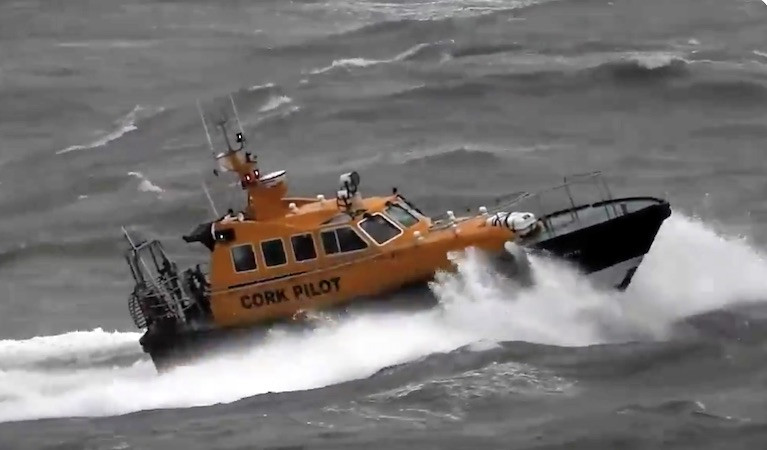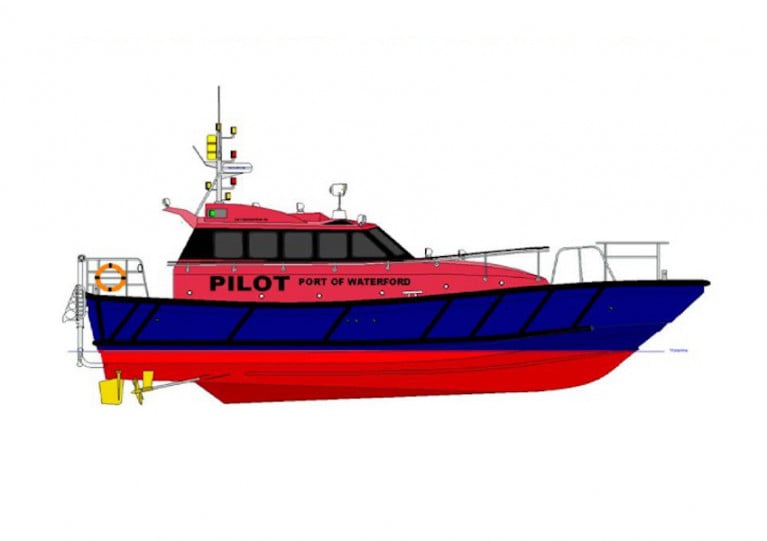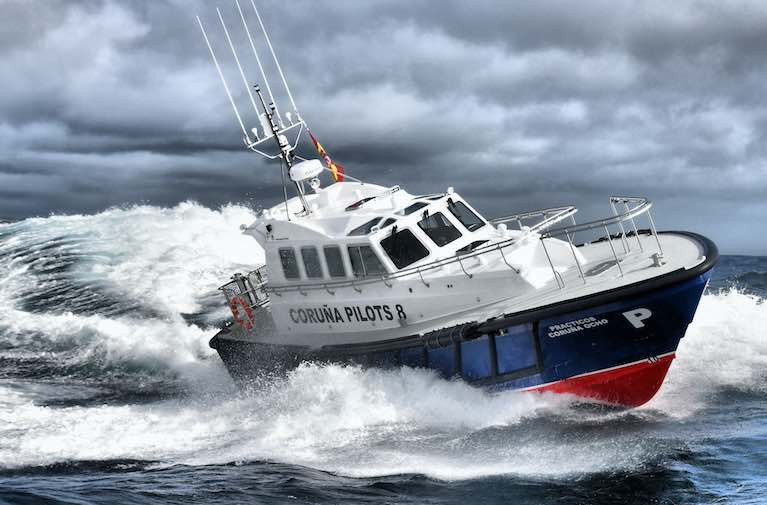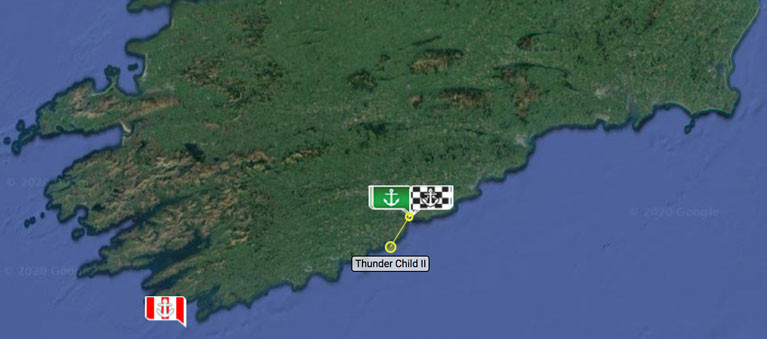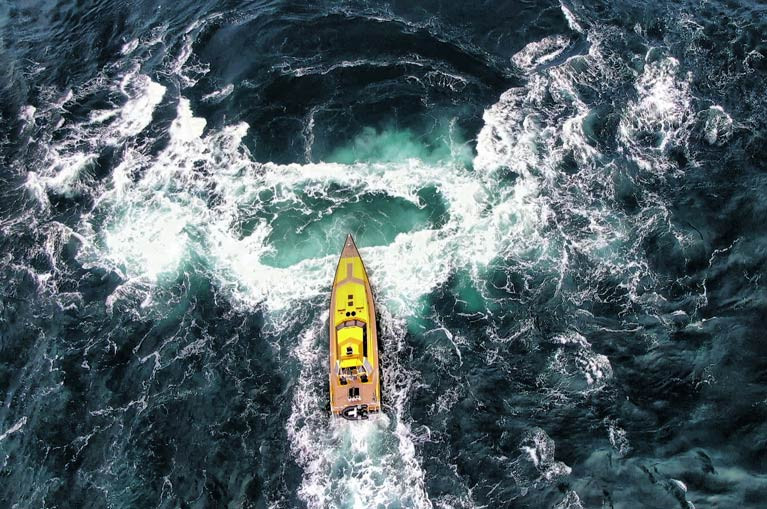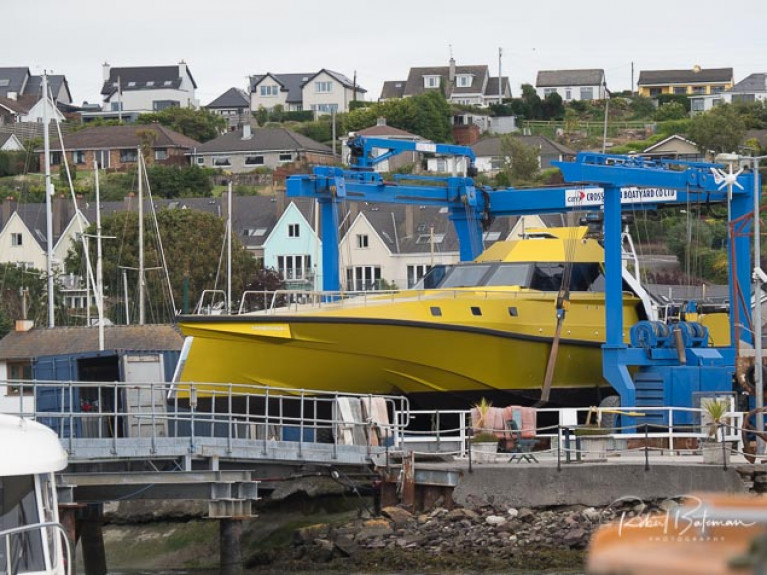Displaying items by tag: Safehaven Marine
Safehaven Marine has released video of sea trials during a recent unseasonal storm which produced some pretty rough conditions at the entrance to Cork Harbour.
The Cork-based performance boatbuilders managed to capture some impressive footage of Thunder Child II and the new Barracuda SV125 on the day.
The Barracuda was commissioned for Future Defence in the USA and is designed for search and rescue as well as coastal patrol duties.
The vessel is fully self-righting, able to recover if capsized by a large breaking sea and capable of all-weather operations.
Its design features a deep ‘V’ hull with midships and transom deadrise of 24 degrees and a wave-piercing bow of 65 degrees giving excellent head sea capabilities.
A wide 4m beam ensures high levels of stability in big beam seas and excellent dynamic stability in following seas. A twin chine arrangement ensures a very dry ride.
Powered by a pair of Caterpillar C8.7 650hp engines, ZF 380 two speed gearboxes with SD3L surface drive propulsion by France Helices, the Barracuda has a maximum speed of 43 knots and a cruise speed of 32 knots at 70% of max power.
At this speed each engine is consuming just 69 litres per hour, giving a 600nm range from the vessel’s long-range fuel tanks.
For much more on the new Barracuda, see the Safehaven Marine website HERE.
New Video from Safehaven Marine Gets Up Close with Rough Weather Testing on Morocco-Bound Pilot Boat
Safehaven Marine has shared video of sea trials for its latest Interceptor 48 pilot boat Oued Martil.
The clip gets up close with the rough weather the boat is designed to handle with ease, including on-board 360-degree camera footage going through big breaking seas — as well as some drone footage on a foggy day alongside Brittany Ferries’ vessel Armorique.
Oued Martil is the third self-righting, all-weather-capable pilot vessel that the Co Cork boat builder has supplied to marine services company Svitzer, this time for their pilotage operations in Tangier, Morocco.
Previous commissions include the Oued Rmel, which was delivered to Tangier with great success in 2018.
Port of Cork Pilots Navigate Big Seas in Interceptor 48 Pilot Boat (VIDEO)
Safehaven Marine captured footage (below) of the Port of Cork Pilots in their Safehaven Built Interceptor 48 Pilot Boat ”Failte” undertaking pilot transfers off Cork Harbour during the recent days of strong south-easterly gales.
Roches Point lighthouse recorded 50 knots of wind on the 13th as the Cosco bulk carrier passes by. The Cork Wave Buoy ( two NM off the harbour entrance) recorded waves of up to 6.7m at the time.
Despite the challenging sea state, the pilot boat coxswain managed to get alongside and safely disembark the pilot.
 The Port Pilot boat off the stern of the Cosco bulk carrier as it departs Cork Harbour Screenshot: Safehaven Marine
The Port Pilot boat off the stern of the Cosco bulk carrier as it departs Cork Harbour Screenshot: Safehaven Marine
Most ports in the world require pilotage, it is the practice where a pilot comes on board near the entrance of the port and then assists the ship's captain with bringing the ship into port and docking or anchoring in the designated anchorage. The pilot also helps provide safe passage when the ship departs.
Afterwards, on the 15th the conditions in Cork Harbour moderated with the Grimaldi car carrier able to depart which Safehaven Marine caught via drone footage.
 The Port of Cork Interceptor 48 Pilot boat alongside the Grimaldi car-carrier Screenshot: Safehaven Marine
The Port of Cork Interceptor 48 Pilot boat alongside the Grimaldi car-carrier Screenshot: Safehaven Marine
The footage documents the essential work of the port, its' pilots and pilot boat crew in keeping the port working and shipping moving in such bad sea and weather conditions.
Port of Cork Pilots in Bad Weather at Cork Harbour Entrance
The Port of Waterford is to invest almost €1 million in a new pilot boat from Safehaven Marine.
Due to come unto use in September 2021, the pilot boat will be named Port Láirge, the Irish for Waterford and a name long associated with a steam-powered dredger that served the city for more than 70 years until the 1980s.
The 15-metre-long boat will provide safer working conditions for pilotage personnel, the port says.
Safehaven Marine in Co Cork won a tendering process to design and build the new boat which will be fitted with the latest marine safety technology.
Recent launches for the Youghal-based performance boatbuilders include Interceptor 48 pilot boats for Montevideo in Uruguay and the Port of Coruna in Northern Spain.
Port of Waterford Harbourmaster Capt Darren Doyle said: “We look forward to the new Port Láirge being brought into service next year.
“Our pilot boat crew and pilots do vitally important work year-round and it is essential that they have the best possible vessel to operate from.”
Safehaven Marine Launch New Interceptor 48 for Port of Coruna, Northern Spain
Specialist Pilot boat builders Safehaven Marine of Cork, have launched a new Interceptor 48 pilot boat for the Port of Coruna in Northern Spain.
‘Practicos Coruna Ochno’ is powered by a pair of Volvo D13 500hp continuously rated engines and ZF Gearboxes. Propulsion is by conventional stern gear turning 28” propellers giving her a 25-knots continuous operational speed. Capable of carrying seven pilots and crew all on shock mitigation seating comfortably in her spacious fully lined cabin with extremely low noise levels of 73db recorded.
 Her central helm position with all-round visibility
Her central helm position with all-round visibility
She is proving very economical using just under 80 litres of fuel per hr on each engine at 25kts. She is heavily fendered all round and incorporating Safehaven’s sacrificial fender system protecting the vessel at her boarding area and softening the inevitable hard impact that can occur in poor conditions. Safehaven’s proven MOB recovery system is fitted on the transom allowing a casualty to be easily recovered in a MOB situation. A full suite of Garmin electronics is installed at her central helm position which provides excellent all-round visibility and control of the craft when undertaking alongside ship pilot transfers.
 (Above and below) The new Interceptor 48 alongside the ‘Taccola’ dredger
(Above and below) The new Interceptor 48 alongside the ‘Taccola’ dredger

Safehaven undertook extensive rough weather sea trials to fully test her and took advantage of being able to do multiple boarding trails alongside the ‘Taccola’ dredger that is operating in Cork harbour presently, demonstrating to clients how nicely she handles alongside and captured some cool photos and video.
 Spacious forward cabin
Spacious forward cabin Capable of carrying seven pilots and crew all on shock mitigation seating
Capable of carrying seven pilots and crew all on shock mitigation seating
Over the next week, she will be prepared for yet another remote Covid forced handover, with the owners being unable to visit at all throughout her construction, which was managed through plenty of online videos and photos which proved very effective.
She is to be shipped to Coruna only a few weeks late in early October. Once in operation there Safehaven expect her to handle admirably the big ‘Bay of Biscay’ seas the port can experience this coming winter.
She is Safehaven’s fifth pilot boat supplied to Spain and 45th pilot boat built overall.
Interceptor 48 pilot boat Principle Dimensions
L.O.A. (Length overall) 14.9m
Beam overall (Including fenders) 4.4m
Draft (Depth of hull below waterline) 1.3m
Displacement Lightship 16,200kg
Fully loaded 18,800kg
Fuel capacity 1800 litres
Water capacity 110 litres
Crew capacity 7 persons
Engines Volvo D13 500hp
Gearboxes ZF500
Propellers 28” 4 blade equipoise
Seating KAB514 suspension seats
Electronics Radar, GPS, Sonar, VHF
Garmin 48nm, 15” & 12” displays, ECDS, Dual-beam graphic display
Icom VHF DSC x2
Subdivision 4 x separate watertight compartments
Classification PRS
Speed (continuous operation) 25kts
Frank Kowalski's World Record Breaking Powerboat Run from Cork to Fastnet Rock & Back in Thunderchild II
Frank Kowalski's Safehaven Marine in County Cork set a new World powerboat record for Cork - Fastnet Rock – Cork yesterday, averaging 44.6 knots and here the Safehaven skipper reviews his record-breaking run.
As Afloat reported earlier, Safehaven Marine set a new over 50ft class Cork to the Fastnet Rock and back UIM World powerboat record in their 23m long XSV20 ‘Thunder Child II’ in a time of 2hrs 36 minutes averaging 44.6kts, recording a maximum speed of 53kts on the run. (subject to ratification by the UIM)
 Thunderchild II makes a start on her successful record-breaking run at Weavers Point, Cork Harbour Photo: Bob Bateman
Thunderchild II makes a start on her successful record-breaking run at Weavers Point, Cork Harbour Photo: Bob Bateman
After a recce trip to the rock the day before, and with near-perfect conditions forecast, we made the decision to have a crack at setting the record the next day. Crossing the start line off Weavers Point at the entrance to Cork Harbour at 2 pm on Sunday the 9th of August in light winds and only a long Atlantic groundswell to contend with, we set off on the first leg heading West. Arriving at the Fastnet Rock 1hrs 21 minutes later we were surprised and delighted to see a huge flotilla of 40-50 boats waiting close by the rock to watch as we passed and wave us on. Although it was a bit stressful navigating through them as we rounded the rock it was simply fabulous to see them all set chase after Thunder Child II as she headed home. Passing the Stags Rock and Kinsale Lighthouse heading East with boats coming out to watch us as she literally thundered home, (there’s some soundtrack from her quad 650hp engines) and putting up a huge rooster tail from her surface drives we crossed the finish line to another great welcome.
 Thunderchild II crew: Skipper Frank Kowalski, Ciaran Monks, Carl Randalls, Mary Power & Robert Guzik
Thunderchild II crew: Skipper Frank Kowalski, Ciaran Monks, Carl Randalls, Mary Power & Robert Guzik
Thunder Child II ran faultlessly during the run looking after her crew of: Skipper Frank Kowalski, Ciaran Monks, Carl Randalls, Mary Power & Robert Guzik. We were kind to her engines keeping them at just 85-90% of full power throughout, only giving her the beans for the final 10miles towards the finish line running at over 50 kts.
Thunderchild II Sets New Powerboat World Record off Cork Coast
County Cork boat builder Safehaven Marine set a new record for an over 50ft vessel from Cork–Fastnet-Cork in its Thunder Child II vessel this afternoon.
Crossing the start line off Weavers Point Cork Harbour at 2.00 pm, skipper Frank Kowalski completed the course in two hours and 36 minutes (subject to ratification by the UIM).
Thunderchild II averaged 44.6 kts with a maximum speed of 53 kts.
This was it passing us near old head earlier #thunderchild2 pic.twitter.com/5mTupjd9Xx
— Seamus Heaney (@heaney_seamus) August 9, 2020
Thunderchild II Cork Fastnet-Cork UIM Powerboat World Record BI Underway (Track HERE!)
County Cork boat builder Safehaven Marine is making a bid at the over 50ft vessel Cork–Fastnet-Cork UIM Powerboat World record in its Thunder Child II.
Crossing the start line off Weavers Point Cork Harbour at 2.00 pm, skipper Frank Kowalski is aiming to round the Fastnet before 3.30 pm this afternoon.
Track live here
Cork Harbour Boat manufacturer Safehaven Marine undertook an 800nm four-day cruise in Thunder Child II to Scotland, living off the boat to visit a place called the Gulf of Corryvreckan. A pretty wild yet beautiful place writes Thunderchild's skipper, Frank Kowalski
The Corryvreckan whirlpool, or ‘Maelstrom’, as would be a more appropriate description, is formed as the tide enters the narrow stretch of water between the Islands of Jura and Scarba that is the Gulf of Corryvreckan. Here the tidal flow speeds up to 8.5kts as it is squeezed between the islands, and there it encounters a variety of underwater seabed features. On the western entrance, a basalt pinnacle rises up from depths of 70m to 29m, and lying to East, directly in front of the pinnacle is a deep hole in the seabed, with a depth of 219m.
 Thunderchild II heading into the standing waves at the Corryvreckan Whirlpool
Thunderchild II heading into the standing waves at the Corryvreckan Whirlpool
As the water flows through the gulf it falls into this hole, and then encounters the steep face of the pinnacle, causing a massive upwelling surge of water to rise to the surface. On a flood tide this surge meets swells entering the Gulf from the west, and creates standing waves that can reach heights of 9m.
 Stationary at 6kts with the waves breaking behind the boat
Stationary at 6kts with the waves breaking behind the boat
These ‘standing waves’ are not like normal waves as they form directly over the pinnacle, standing still and breaking heavily on the spot. Whirlpools are also formed over the pinnacle as well as throughout the Gulf, as opposing water columns sheer, and these can be up to 50m wide.
 Submarine topography of the Gulf of Corryvreckan
Submarine topography of the Gulf of Corryvreckan
During a storm on spring tides, it is said that the angry roar from the seething waters of the maelstrom, with its standing waves and whirlpools, can be heard up to 10 miles away, and local mythology refers to this as the voice of ‘Cailleach’ (The Hag) of the Whirlpool.
In a well-found boat, the gulf can be safely navigated in fair conditions, or at slack water, but I can imagine that in a Westerly gale on a flood tide, you wouldn’t want to be anywhere near the place, as it would truly be described as ‘Unnavigable’. Indeed it was once classified as such by the Royal Navy.
On the day we visited with Thunder Child we had westerly winds of Force 5 gusting 6, and a 3.9m tide which enabled us to experience the standing waves on the flood and the whirlpools on the ebb.
The word Corryvreckan translates to ‘Cauldron’ and that perfectly describes the seething sea state around the whirlpools, and it was quite an experience to have the throttles set for 6kts, holding station just ahead of the standing waves that were breaking behind the boat, and not be moving at all!
There is an Old Irish text known as Cormac’s Glossary written by the King and Bishop of Cashel, Cormac mac Cuilennáin who died in the year 908: “There is a great whirlpool which is between Ireland and Scotland to the north, in the meeting of various seas, its thunderous eructation and its bursting and its roaring are heard among the clouds, like the steam boiling of a cauldron of fire.”
I felt that was a pretty cool description of the place as how the place might have appeared of old during a storm.
Coryvreckan is reputed to produce the third largest whirlpools after the Saltstraumen and Moskstraumen Maelstroms in Norway, however the unique submarine topography of the gulf of Corryvreckan and its capability to produce dangerous standing waves means that in storm conditions, it is potentially one of the most violent stretches of water in the world.
The Voyage North from Cork Harbour to Corryvreckan
 Corryvreckan at Ardbeg Marina with a rainbow as a symbol of hope for a successful trip
Corryvreckan at Ardbeg Marina with a rainbow as a symbol of hope for a successful trip
As Afloat previously reported, Casting off at Cobh in the afternoon on Saturday 18th July 2020 Thunder Child II arrived at Bangor marina at 9.30pm for refuelling after averaging 32kts over the 275nm run. Overnighting on aboard we set sail early Sunday morning heading up the Northern Ireland coast to Rathlin Island, itself a place notorious for producing challenging seas with its tidal strong race and overfalls, before a lumpy crossing to Scotland to enjoying two days taking Thunder Child II through the standing waves and whirlpools in the Gulf of Corryvreckan, and capturing some cool Ariel drone video.
 (Above and below) Thunderchild II alongside at Bangor Marina in County Down
(Above and below) Thunderchild II alongside at Bangor Marina in County Down

Whilst we were there It was also nice to see one of our old Interceptor 42 passenger boats ‘Venturer’ for the first time since we built her 15 years ago, and still looking good. Operated by Craignish Cruises running boat tours in the Gulf, they guided us on a tour around the islands visiting the notorious ‘Grey Dogs’ tidal race and seeing the Sea Eagles nesting nearby.
 Thunderchild on her 800nm odyssey to Corryvreckan off the Scottish West Coast
Thunderchild on her 800nm odyssey to Corryvreckan off the Scottish West Coast
Spending Sunday night isolated on the breakwater at Ardfern marina we headed to Belfast late afternoon on Monday. Next day we were onwards to Dun Laoghaire for lunch and down the East coast of Ireland where we were buzzed overhead by Rescue 117 of the Irish Coastguard, which was great to experience and gave us the excuse to give Thunder Child the beans, and although heavy with fuel we still managed to hit over 50kts.
 In the amazingly clear waters of the North, Thunder Child II’s quad propellers quite clearly over the transom
In the amazingly clear waters of the North, Thunder Child II’s quad propellers quite clearly over the transom
 Thunderchild II Leaves Bangor Marina, her golden colour glistening in the sun and below
Thunderchild II Leaves Bangor Marina, her golden colour glistening in the sun and below
We arrived home to East Ferry Marina, Cobh late Tuesday evening after an enjoyable voyage for her crew comprising: Skipper Frank Kowalski and crew: Carl Randalls (Drone pilot) Ciaran Monks, Mary Power and Kenny Carrol. During the voyage, Thunder Child II ran faultlessly and proved her capabilities of averaging high speeds for long distances.
 Thunderchild II crew: Skipper Frank Kowalski and crew: Carl Randalls (Drone pilot) Ciaran Monks, Mary Power and Kenny Carrol
Thunderchild II crew: Skipper Frank Kowalski and crew: Carl Randalls (Drone pilot) Ciaran Monks, Mary Power and Kenny Carrol
Thunder Child II Specification
- L.O.A. 23m
- Beam 5.4m
- Displacment 25,000kg ( lightship)
- Fuel capacity 8,000L
- Range 750nm
- Propulsion 4x Caterpillar C8.7 650hp engines, 4x France Helices SD23L Surface drives
- Speed Max 54kts, Cruise 32-40kts
Safehaven Marine's Frank Kowalski has announced that his planned Trans-Atlantic record attempt this year in Thunder Child II has been postponed.
Speculation mounted this week when the asymmetrical catamaran was lifted out of the water in Cork Harbour that it might be the start of record bid preparations.
Kowalski told Afloat 'Regretfully Safehaven Marine have had to postpone our planned Trans-Atlantic record attempt this year in Thunder Child II. This is due to the COVID 19 crisis and the global logistical and travel restrictions in place'.
It had previously been indicated that between July and August 2020 the same five-member crew that set a record time Round Ireland also aboard Thunder Child II, would attempt an unprecedented 4,500 km transatlantic route from Killybegs to Newfoundland via refuelling stops at Greenland and Iceland.
Kowalski also told Afloat via social media: "Due to the very small Greenland sea ice and North Atlantic weather window that existed for us to make the attempt, sadly it is not going to be possible for us to undertake the voyage this year".



























